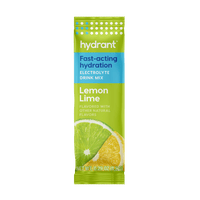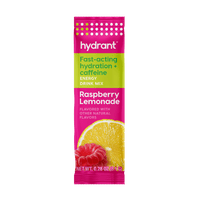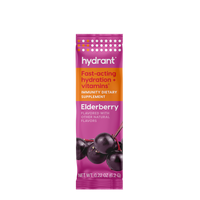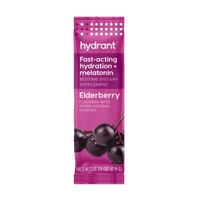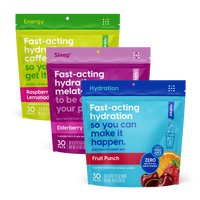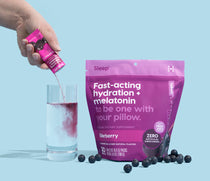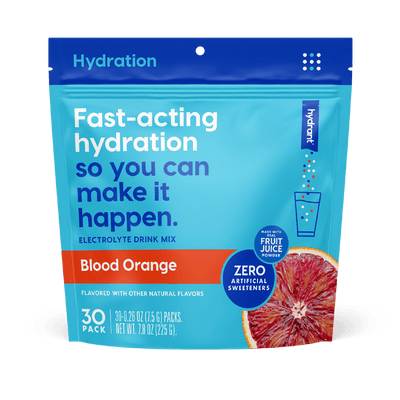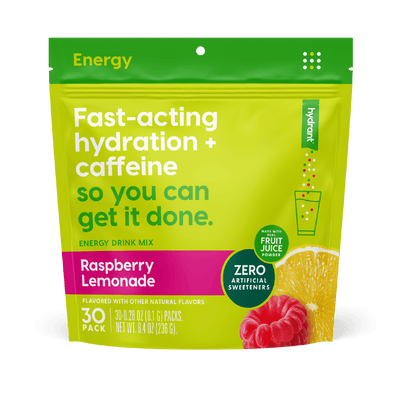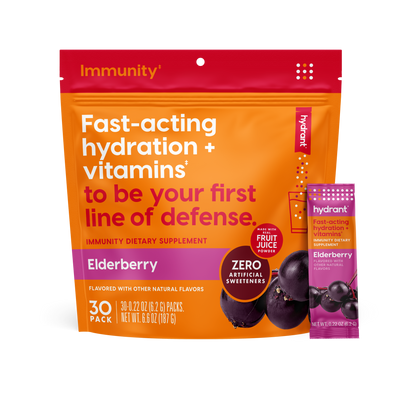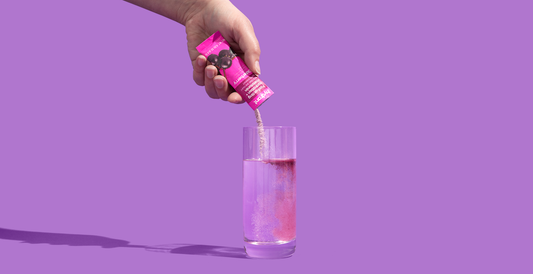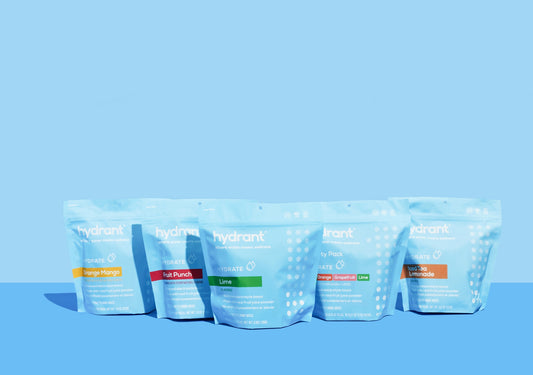What we eat matters, but how aware are you of what you’re actually putting in your body? Just read the Nutrition Facts! Ok, easier said than done.
We know nutrition labels may seem intimidating, but don’t worry! We’ll walk you through how to read a nutrition label, so that you can get the most out of what you eat and drink.
How to Read a Nutrition Label
Nutrition labels are required by the U.S. Food and Drug Administration for almost all prepared food, and are included on some fresh foods, such as fruits and fish [1]. But what’s on these labels, and how do we make heads or tails of it all?
Here’s our handy guide to reading nutrition labels, working through the example below.

An Example Nutrition Label; Image supplied by the FDA for educational purposes.
Step One: Serving Size
The first thing to look at is serving size, which is usually the first thing on the label—see point 1 on the diagram above. All the information on the label is usually reported with respect to this serving size. Don’t get tricked by the common misconception that the label applies to the entire contents of the package; more often than not, serving size is not what you expect! In some energy drinks, even though it’s one bottle, there are often two portions. This means you’re giving your body twice as many calories, and twice as much sugar as you think. If you’re indulging in two servings in one sitting, simply double each of the reported values.
Some servings are listed in terms of size, instead of potion, with all nutritional values reported ‘per 100ml’ or ‘per 100g,’ instead of ‘per single serving.’ If that’s the case, be sure to compare this value with the net weight (often listed on the front of the package near the bottom) and simply divide the total weight with the suggested serving size to get amount of servings per package.
Step Two: Calories
This is the easy bit—most of us already look at the calorie count. The number of calories is usually written in big bold letters near the top of the nutritional information. See point 2 in the above diagram.
Calories are usually expressed as a whole number, and then as a percentage of a 2,000 total calorie recommended daily intake. However, it’s worth bearing in mind that your recommended intake daily might be quite different from 2,000!
Here’s an extract from the recommended calorie intake table from the Dietary Guidelines for Americans 2015-2020 report. The full table can be viewed here [2]. Using your age, sex and activity level, you can get a better estimate of how many calories you should be consuming per day to maintain your current weight.
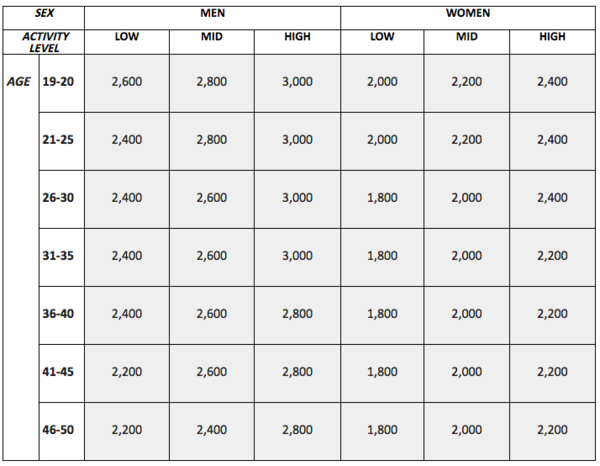
Table One: Recommended daily calorie intake for males and females between 19 and 50 years, by age and activity level.
When counting calories, be aware of how quickly they may stack up over the course of the day—or within the first course! —and don’t forget to include drinks. An 11-ounce carton of coconut water is an average of 60 calories [3]. Coconut water is not the “empty calories” of water that most people assume it to be!
While we’re on the topic, take a peek at point 5 on the diagram - ‘Percent Daily Value’. It’s not just calories that are listed as whole numbers and percentage of daily recommended intake. All the other nutrients are listed this way too. This includes macronutrients, like fats and sugars, and micronutrients, such as vitamins.
You can find out your recommended intake of each nutrient group here, according to age and sex [2].
Step 3: Best-to-Avoid Nutrients
The next step is to assess the negative impact of what you’re eating. In yellow on the above diagram are the nutrients to which you should pay close attention and which you should avoid consuming in excess. Here are the four major groups to watch out for, highlighted in the diagram above:
Saturated Fats. These are not needed by the body, and wherever possible, should be replaced with unsaturated fats. You should not get more than 10% of your calories each day from saturated fats [4].
Trans Fats (or hydrogenated fats). These should be avoided as much as possible. There are higher amounts of these sorts of fats found in processed fatty foods, like pizzas, margarines, and prepared desserts [4].
Cholesterol. This is important for body function, but is already (usually) made in sufficient quantities by your body. There’s little need for cholesterol in your diet, so doctors cringe when they see high cholesterol levels on nutrition labels. Cholesterol is naturally in some foods that are important sources of proteins, but try to avoid any excess [4].
Sodium. It’s important to pay attention to sodium levels. Sodium is an electrolyte and a key element of table salt. Electrolytes are really important for good hydration, and have specific vital roles in the body. Even so, most Americans consume too much sodium in their daily diets. Try to avoid high levels of sodium in processed food and cut down on adding salt to your food [4]. Everything in moderation.

Sugars. We also want to highlight sugars. Health foods and sports drinks usually don’t pose too much of a fat-threat, but many manufactured drinks are loaded with sugar. Sodas and energy drinks are the main culprits—yep, even those marketed as “diet” or “healthy!” If consuming these beverages, be sure to not exceed one portion in order to keep your sugar intake down. (Wink wink at only 20 calories per packet, Hydrant is a great alternative!)
Step 4: The ‘Gimme More’ Nutrients
The final step is to clock the added benefits you’re getting from your food and drink. There are some nutrients that we simply don’t get enough of in our western diets. These include dietary fiber, vitamin A, vitamin C, calcium, and iron. Fresh foods are a great place to start for these sorts of nutrients [4]. Staying healthy is just as much a balance of maximizing the good as it is minimizing the bad.
Here’s our summary of Nutrition Label pro-tips:
- Limit yourself to one recommended serving at a time (ahem, that usually means not the entire bag)
- Work out your own daily recommended values for calories and nutrients
- Be wary of high sugar and fat intakes
- Practice self-care in diligently increasing your daily vitamin and fiber intake
And finally...
Like in point 6 of the example above, some nutritional labels will have footnotes that give a rundown of daily allowances to help you keep on track. There are also plenty of apps you can download that can help you tailor your dietary requirements and work out how to optimize your diet without making you count calories. Check out MyFitnessPal.
They may seem intimidating at first, but nutrition labels are relatively easy to digest (ha, pun intended!) if know what to look for. In fact, nutrition labels may just be the most underrated tool in staying healthy, happy, and hydrated.
Writer: Ailsa McKinlay
Editor: Elizabeth Trelstad, www.hellobeaker.com
